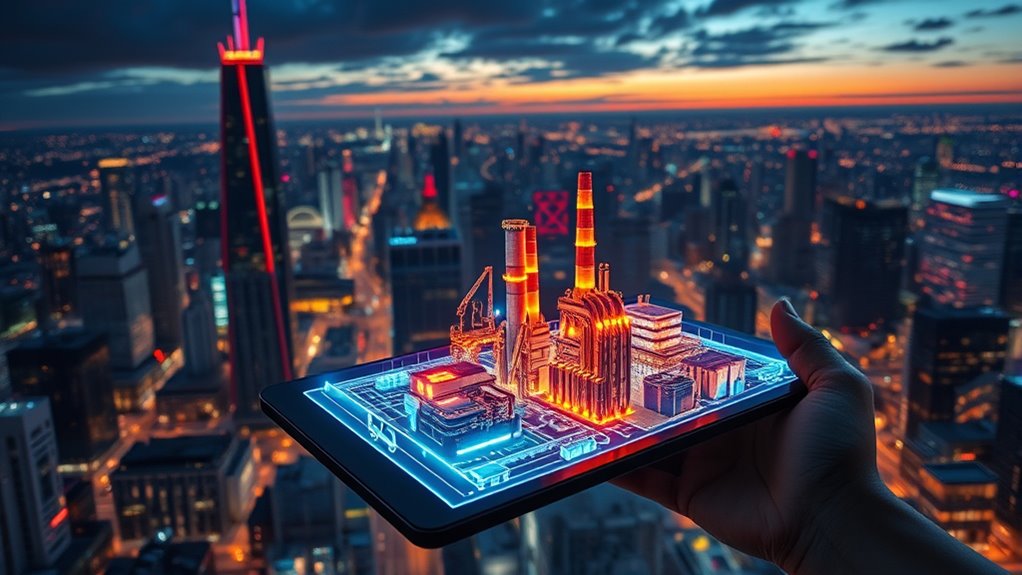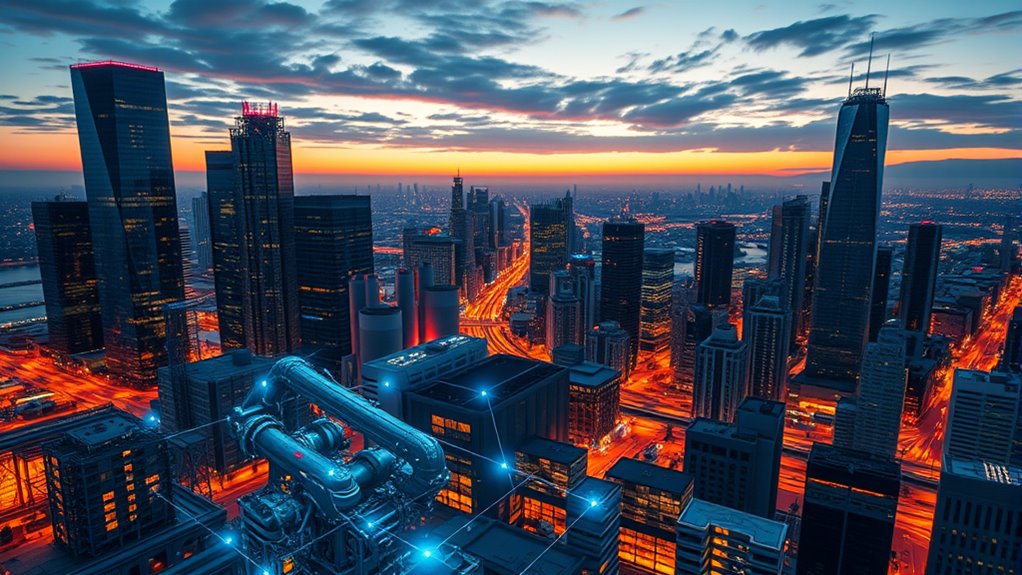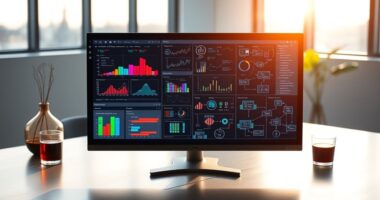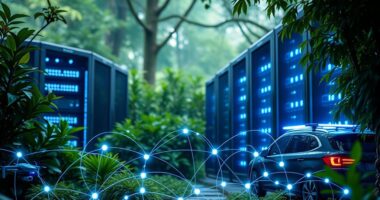Digital twins create virtual replicas of physical assets, allowing you to monitor, analyze, and optimize operations in real-time. In manufacturing, they help streamline production and predict equipment failures before they happen. For smart cities, digital twins simulate traffic, energy, and water systems to improve efficiency and sustainability. As you explore further, you’ll discover how these digital models are transforming industries by bridging physical and digital worlds for smarter management.
Key Takeaways
- Digital twins create virtual replicas of physical assets to enable simulation, monitoring, and optimization across industries.
- Virtual modeling and real-time data synchronization ensure accurate, dynamic representations of equipment and infrastructure.
- Predictive analytics forecast failures and performance issues, supporting proactive maintenance and operational efficiency.
- In manufacturing and urban planning, digital twins optimize workflows, reduce costs, and improve city infrastructure management.
- They bridge physical and digital worlds, fostering smarter, resilient systems with ongoing data-driven insights.

Have you ever wondered how industries optimize performance and maintenance in real time? The answer lies in the fascinating world of digital twins. These virtual replicas of physical assets or systems allow you to simulate, analyze, and improve operations without disrupting the real-world counterparts. Central to this technology is virtual modeling, which creates detailed digital counterparts that mirror the behavior and conditions of your equipment or infrastructure. By leveraging these models, you gain a dynamic view of how your assets operate under various scenarios. As data flows from sensors and IoT devices, the digital twin updates continuously, providing a real-time reflection of the physical entity. This constant synchronization enables you to identify issues early and plan interventions proactively.
Predictive analytics plays a crucial role in enhancing the power of digital twins. By analyzing historical and real-time data, predictive models forecast potential failures or performance dips before they happen. Imagine receiving alerts that a machine is likely to malfunction within the next 48 hours, giving you the opportunity to schedule maintenance during non-peak hours. This approach reduces downtime, cuts costs, and extends the lifespan of your equipment. Instead of relying solely on reactive repairs, you adopt a proactive strategy that keeps your operations running smoothly. The combination of virtual modeling and predictive analytics transforms maintenance from a costly, disruptive process into a streamlined, intelligent activity.
In manufacturing, digital twins enable you to simulate production lines, optimize workflows, and test new configurations virtually. Instead of costly trial-and-error in physical environments, you experiment within the digital realm, saving time and resources. You can also monitor equipment health continuously, adjusting operations based on real-time insights. When it comes to smart cities, digital twins help you visualize entire urban infrastructures—traffic flows, energy grids, water systems—and optimize their performance. Traffic congestion, for instance, can be alleviated by analyzing patterns and adjusting signals dynamically. Similarly, energy consumption can be minimized by modeling different scenarios and choosing the most efficient solutions. These digital representations empower city planners and engineers to make data-driven decisions that improve quality of life and sustainability.
Ultimately, digital twins, with their virtual modeling and predictive analytics capabilities, offer you a way to understand and control complex systems more effectively. They bridge the gap between the physical and digital worlds, enabling smarter, more responsive operations across various industries. Whether in manufacturing or urban planning, these tools help you anticipate problems, optimize resources, and innovate faster—all while reducing risks and costs. The future of digital twins is about creating smarter environments where data-driven insights lead to continuous improvement and resilience.
Frequently Asked Questions
How Do Digital Twins Ensure Data Privacy and Security?
You want to know how digital twins keep data private and secure. They use data encryption to protect sensitive information from unauthorized access and guarantee data remains confidential during transfer and storage. Access control systems restrict who can view or modify the twin’s data, adding an extra security layer. By combining data encryption and access control, digital twins maintain robust security, safeguarding your data from breaches and ensuring privacy.
What Are the Costs Associated With Implementing Digital Twin Technology?
When you consider the costs of implementing digital twin technology, you should account for initial implementation costs, including software, hardware, and integration efforts. Maintenance expenses, such as updates and system monitoring, also add up over time. These costs vary depending on the complexity and scale of your project. While investments can be significant, the long-term benefits of improved efficiency and decision-making often justify the expenses.
How Do Digital Twins Adapt to Real-Time Changes in Environments?
Imagine a digital twin as your environment’s attentive partner, seamlessly adjusting to environmental adaptation. It uses real-time synchronization to reflect changes instantly, ensuring accurate monitoring and decision-making. As conditions shift, the twin updates its data swiftly, allowing you to respond proactively. This dynamic process keeps systems optimized and responsive, making digital twins invaluable for managing complex environments with precision and agility.
What Industries Are Most Benefiting From Digital Twin Applications?
You’ll find that industries like manufacturing and urban planning are reaping the most benefits from digital twin applications. Digital twins boost manufacturing efficiency by simulating processes and predicting maintenance needs, reducing downtime. In urban planning, they help design smarter cities by modeling infrastructure, traffic, and environmental impacts. These applications enable better decision-making, optimize resource use, and enhance overall system performance, transforming how these industries operate and plan for the future.
How Do Digital Twins Impact Long-Term Infrastructure Planning?
Imagine a future where your city’s growth feels seamless. Digital twins gently guide long-term infrastructure planning through urban integration, offering detailed insights and foresight. They enable predictive maintenance, reducing unexpected disruptions and optimizing resource use. By simulating scenarios, you can anticipate needs and make smarter decisions, ensuring sustainable development. This proactive approach helps create resilient, efficient cities that adapt gracefully to change, making urban living more enjoyable and sustainable for everyone.
Conclusion
Just as Icarus dreamed of touching the sun, you can now harness the power of digital twins to elevate manufacturing and transform cities into living, breathing entities. These virtual replicas act as your guiding stars, helping you anticipate issues and optimize growth. Embrace this technology, and you’ll navigate the future with confidence, turning imagination into reality. The sky’s the limit—so reach for it, knowing digital twins are your wings.








